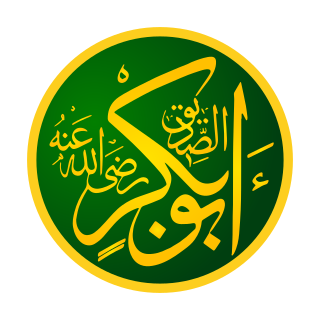Related Research Articles

Abu Bakr was the founder and first caliph of the Rashidun Caliphate ruling from June 632 until his death. He was the most prominent companion, closest advisor and a father-in-law of the Islamic prophet Muhammad.

Umm Salama Hind bint Abi Umayya, also known as Hind al-Makhzumiyah was one of the wives of Islamic prophet Muhammad.
Maria bint Shamʿūn, better known as Maria al-Qibtiyya, Maria Qubtiyya, or Mary the Copt, was an Egyptian who, along with her sister Sirin, was sent to the Islamic prophet Muhammad in 628 as a gift by Muqawqis, a Christian governor of Alexandria, Egypt, during the territory's Persian occupation. She and her sister were slaves. She spent the rest of her life in Medina where she converted to Islam and lived with Muhammad where she bore a son, Ibrahim. The son would die as an infant and then she died almost five years later.

Thirteen women were married to the Islamic prophet Muhammad. Muslims use the term Umm al-Mu'minin prominently before or after referring to them as a sign of respect, a term derived from Quran 33:6.

Abd al-Rahman ibn Awf was an Arab businessman, entrepreneur and investor. Among the wealthiest traders of 7th-century Arabia, Abd al-Rahman owned a large number of camels, horses and sheep.
Usama ibn Zayd was an early Muslim and companion of the Islamic prophet Muhammad.

Bilāl ibn Rabāḥ, c. 580–640, was one of the most trusted and loyal Sahabah (companions) of the Islamic prophet Muhammad. He was born in Mecca and is considered to have been the first mu'azzin in history, chosen by Muhammad himself. He was a former slave and was known for his voice with which he called people to their prayers. He died in 640, about the age of 60.
Amr ibn Hisham was a Meccan Qurayshi polytheist leader, known for his opposition towards the Islamic prophet Muhammad and his persecution of early Muslims in Mecca. He was the most prominent flag-bearer of opposition towards Islam.
Zayd ibn Haritha ibn Sharahil al-Kalbi was a Muslim military commander in the service of the Islamic prophet Muhammad.

The Banū Khuzāʿah is the name of an Azdite, Qaḥṭānite tribe, which is one of the main ancestral tribes of the Arabian Peninsula. They ruled Mecca for a long period, prior to the Islamic prophet Muhammad's rule, and many members of the tribe now live in and around that city, but are also present in significant numbers in other countries, mainly Iraq, Palestine, and Jordan but also numbers can be found in Lebanon, Egypt, Libya, Syria, Qatar, Bahrain, Kuwait and UAE. The tribe acted as the custodians of Mecca before the Quraysh. They were the ruling kings of the Emirate of what is now modern-day Iraq, until the invasion of the Ottoman Empire in the late 1800s and were the rulers of the kingdom of the Middle Euphrates until the early-mid 20th century.
Safwan ibn Umayyah was a sahabi (companion) of the Islamic prophet Muhammad.
The Conquest of Mecca was the capture of the town of Mecca by Muslims led by the Islamic prophet Muhammad in December 629 or January 630 AD (Julian), 10–20 Ramadan, 8 AH. The conquest marked the end of the wars between the followers of Muhammad and the Quraysh tribe.

In the early days of Islam at Mecca, the new Muslims were often subjected to abuse and persecution. The persecution lasted for 12 years beginning from the advent of Islam to Hegira. Muhammad preached Islam secretly for 3 years. Then, he openly preached Islam, resulting in public prosecutions to take place, and even more dreadfully. Muhammad and his followers were first belittled and ridiculed, then persecuted and physically attacked for departing from traditional Mecca's tribal ways.

Dihya ibn Khalifa, better known as Dihyah al-Kalbi, sometimes spelled Dahyah, was a companion of the Islamic prophet Muhammad. He is well-known for sending Muhammad's invitation message to the Roman Emperor Heraclius. Dihyah belonged to the tribe of Banu Kalb and was the paternal ancestor of Moorish scholar Ibn Dihya al-Kalby.

Sa'd ibn Mu'adh (c.590-627) was the chief of the Aws tribe in Medina and one of the prominent companions of the Islamic prophet Muhammad. He died shortly after the Battle of the Trench.
The Expedition of al Raji, occurred directly after the Battle of Uhud in the year AH 4 of the Islamic calendar.
The invasion of Banu Nadir took place in May AD 625 4. The account is related in Surah Al-Hashr which describes the banishment of the Jewish tribe Banu Nadir who were expelled from Medina after plotting to assassinate the Islamic prophet Muhammad.
The Banu Fazāra were an Arab tribe whose original homeland was Najd.
Ayman ibn Ubayd, was an early Muslim and companion of the Islamic prophet Muhammad.
References
- 1 2 3 4 Mubarakpuri, Saifur Rahman Al (2005), The sealed nectar: biography of the Noble Prophet, Darussalam Publications, p. 395 (online)
- ↑ Atlas of the Quran, Shawqī Abū Khalīl, Pg 242
- ↑ Hawarey, Mosab (2010). The Journey of Prophecy; Days of Peace and War (Arabic). Islamic Book Trust.Note: Book contains a list of battles of Muhammad in Arabic, English translation available here
- ↑ Muḥammad Ibn ʻAbd al-Wahhāb, Mukhtaṣar zād al-maʻād, p. 345.
- ↑ Sirat Halabiyya 2/192
- ↑ Tabari Vol.8:Page.96
- ↑ Sahih Muslim , 19:4345